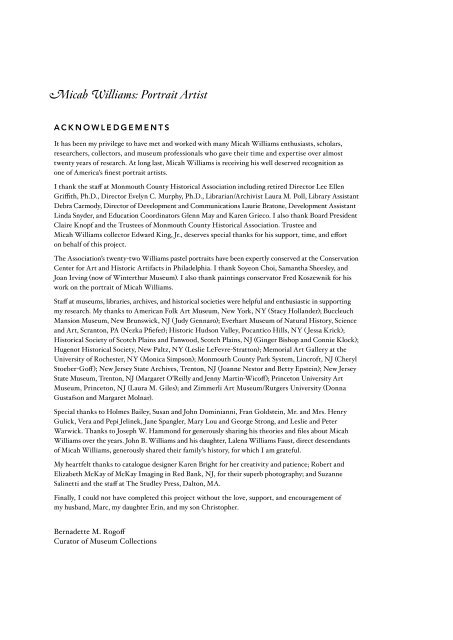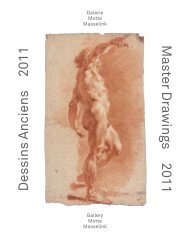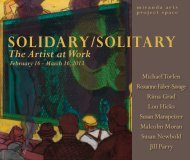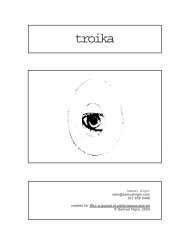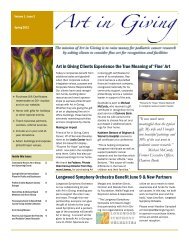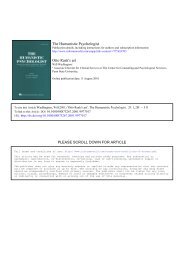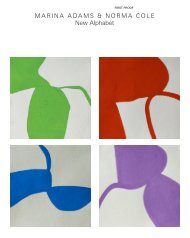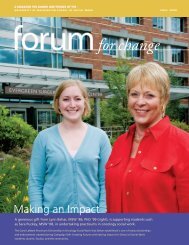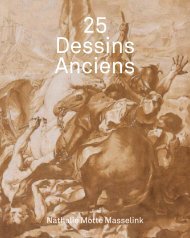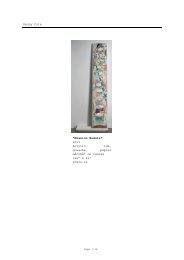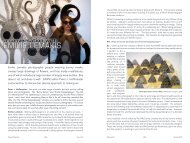Micah Williams Portrait Artist - Icompendium
Micah Williams Portrait Artist - Icompendium
Micah Williams Portrait Artist - Icompendium
You also want an ePaper? Increase the reach of your titles
YUMPU automatically turns print PDFs into web optimized ePapers that Google loves.
<strong>Micah</strong> <strong>Williams</strong>: <strong>Portrait</strong> <strong>Artist</strong><br />
Acknowledgements<br />
It has been my privilege to have met and worked with many <strong>Micah</strong> <strong>Williams</strong> enthusiasts, scholars,<br />
researchers, collectors, and museum professionals who gave their time and expertise over almost<br />
twenty years of research. At long last, <strong>Micah</strong> <strong>Williams</strong> is receiving his well deserved recognition as<br />
one of America’s finest portrait artists.<br />
I thank the staff at Monmouth County Historical Association including retired Director Lee Ellen<br />
Griffith, Ph.D., Director Evelyn C. Murphy, Ph.D., Librarian/Archivist Laura M. Poll, Library Assistant<br />
Debra Carmody, Director of Development and Communications Laurie Bratone, Development Assistant<br />
Linda Snyder, and Education Coordinators Glenn May and Karen Grieco. I also thank Board President<br />
Claire Knopf and the Trustees of Monmouth County Historical Association. Trustee and<br />
<strong>Micah</strong> <strong>Williams</strong> collector Edward King, Jr., deserves special thanks for his support, time, and effort<br />
on behalf of this project.<br />
The Association’s twenty-two <strong>Williams</strong> pastel portraits have been expertly conserved at the Conservation<br />
Center for Art and Historic Artifacts in Philadelphia. I thank Soyeon Choi, Samantha Sheesley, and<br />
Joan Irving (now of Winterthur Museum). I also thank paintings conservator Fred Koszewnik for his<br />
work on the portrait of <strong>Micah</strong> <strong>Williams</strong>.<br />
Staff at museums, libraries, archives, and historical societies were helpful and enthusiastic in supporting<br />
my research. My thanks to American Folk Art Museum, New York, NY (Stacy Hollander); Buccleuch<br />
Mansion Museum, New Brunswick, NJ ( Judy Gennaro); Everhart Museum of Natural History, Science<br />
and Art, Scranton, PA (Nezka Pfiefer); Historic Hudson Valley, Pocantico Hills, NY ( Jessa Krick);<br />
Historical Society of Scotch Plains and Fanwood, Scotch Plains, NJ (Ginger Bishop and Connie Klock);<br />
Hugenot Historical Society, New Paltz, NY (Leslie LeFevre-Stratton); Memorial Art Gallery at the<br />
University of Rochester, NY (Monica Simpson); Monmouth County Park System, Lincroft, NJ (Cheryl<br />
Stoeber-Goff); New Jersey State Archives, Trenton, NJ (Joanne Nestor and Betty Epstein); New Jersey<br />
State Museum, Trenton, NJ (Margaret O’Reilly and Jenny Martin-Wicoff); Princeton University Art<br />
Museum, Princeton, NJ (Laura M. Giles); and Zimmerli Art Museum/Rutgers University (Donna<br />
Gustafson and Margaret Molnar).<br />
Special thanks to Holmes Bailey, Susan and John Dominianni, Fran Goldstein, Mr. and Mrs. Henry<br />
Gulick, Vera and Pepi Jelinek, Jane Spangler, Mary Lou and George Strong, and Leslie and Peter<br />
Warwick. Thanks to Joseph W. Hammond for generously sharing his theories and files about <strong>Micah</strong><br />
<strong>Williams</strong> over the years. John B. <strong>Williams</strong> and his daughter, Lalena <strong>Williams</strong> Faust, direct descendants<br />
of <strong>Micah</strong> <strong>Williams</strong>, generously shared their family’s history, for which I am grateful.<br />
My heartfelt thanks to catalogue designer Karen Bright for her creativity and patience; Robert and<br />
Elizabeth McKay of McKay Imaging in Red Bank, NJ, for their superb photography; and Suzanne<br />
Salinetti and the staff at The Studley Press, Dalton, MA.<br />
Finally, I could not have completed this project without the love, support, and encouragement of<br />
my husband, Marc, my daughter Erin, and my son Christopher.<br />
Bernadette M. Rogoff<br />
Curator of Museum Collections<br />
<strong>Micah</strong> <strong>Williams</strong>: <strong>Portrait</strong> <strong>Artist</strong><br />
from the president of the boArd of trustees<br />
Folk art provides a powerful forum for individual self-expression. Seen over the centuries throughout<br />
the world, folk art reflects cultural identity through art forms of diverse groups – tribal, ethnic, religious,<br />
occupational, geographic, or age or gender based. As our global community becomes increasingly<br />
homogenized through modern technology, folk art is valued more than ever before because it offers<br />
an informed connection to our particular pasts.<br />
<strong>Micah</strong> <strong>Williams</strong>: <strong>Portrait</strong> <strong>Artist</strong> tells a story specific to a time and place, the new America of the nineteenth<br />
century. <strong>Micah</strong> <strong>Williams</strong> traveled extensively in and around Monmouth County during his years as a<br />
portraitist. This exhibition traces the transformation of the artist from his first career as a New Brunswick<br />
silver plater to traveling portrait artist, placing his work into the larger context of social change and<br />
American economic development. Bringing sixty-seven of <strong>Williams</strong>’ works together for the first time,<br />
the exhibition also offers viewers the opportunity to explore family relationships among the sitters.<br />
The clothing, furniture, backgrounds and props featured in the portraits allow us a glimpse into a prospering<br />
agrarian society.<br />
Monmouth County Historical Association has embraced <strong>Williams</strong>’ work since the 1930’s. Between 1950<br />
and 1960, a certain Monmouth County resident, Mrs. Irwin Fearn Cortelyou, published four scholarly<br />
articles for Antiques magazine drawn from her research on the <strong>Williams</strong> portraits in the Association’s<br />
collection. Now, over fifty years later, the Association still holds the largest public collection of <strong>Micah</strong><br />
<strong>Williams</strong>’ work. During the past twenty years, our collection has been under the care of Curator<br />
Bernadette Rogoff. Mrs. Rogoff has expanded the collection while enthusiastically researching the artist<br />
and his patrons. Under her stewardship, each pastel portrait has been conserved by the Conservation<br />
Center for Art and Historic Artifacts in Philadelphia.<br />
The exhibition speaks to our mission of preserving and sharing Monmouth County’s history and culture.<br />
Funding for the project has come from public agencies, corporate sponsors and private donors. The<br />
New Jersey Historical Commission has provided support for the exhibition through a project grant;<br />
Monmouth County Arts Council and Freehold Savings Bank have funded the Picture YourSelf interactive<br />
educational display in our Discovery Room; and Donna and Marvin Schwartz have underwritten the<br />
exhibition catalogue. An anonymous private donor has generously matched all of these contributions.<br />
On behalf of the Board of Trustees of Monmouth County Historical Association, I extend our sincere<br />
thanks and congratulations to all who have made <strong>Micah</strong> <strong>Williams</strong>: <strong>Portrait</strong> <strong>Artist</strong> possible. Our common<br />
appreciation for folk art has given us the opportunity to work together over many years. We look forward<br />
to welcoming you to this celebration of American folk artist <strong>Micah</strong> <strong>Williams</strong>.<br />
Claire M. Knopf<br />
President


